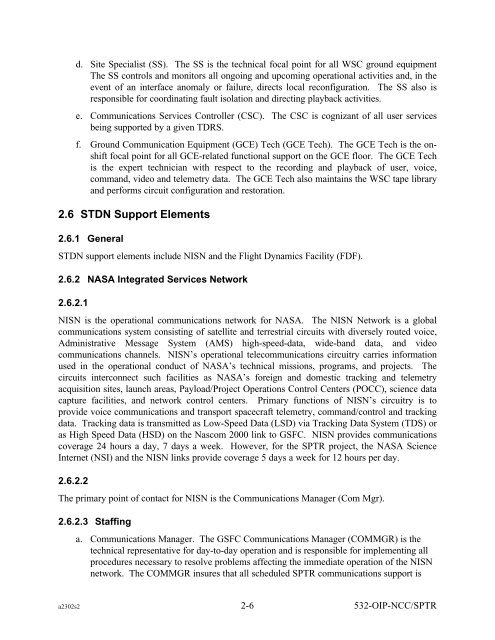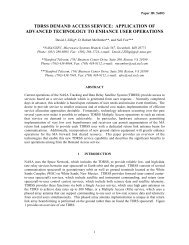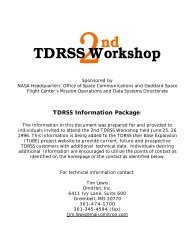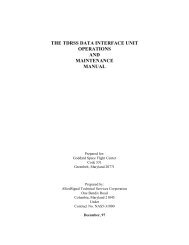Operational Interface Procedures for the South Pole TDRSS Relay ...
Operational Interface Procedures for the South Pole TDRSS Relay ...
Operational Interface Procedures for the South Pole TDRSS Relay ...
Create successful ePaper yourself
Turn your PDF publications into a flip-book with our unique Google optimized e-Paper software.
d. Site Specialist (SS). The SS is <strong>the</strong> technical focal point <strong>for</strong> all WSC ground equipment<br />
The SS controls and monitors all ongoing and upcoming operational activities and, in <strong>the</strong><br />
event of an interface anomaly or failure, directs local reconfiguration. The SS also is<br />
responsible <strong>for</strong> coordinating fault isolation and directing playback activities.<br />
e. Communications Services Controller (CSC). The CSC is cognizant of all user services<br />
being supported by a given TDRS.<br />
f. Ground Communication Equipment (GCE) Tech (GCE Tech). The GCE Tech is <strong>the</strong> onshift<br />
focal point <strong>for</strong> all GCE-related functional support on <strong>the</strong> GCE floor. The GCE Tech<br />
is <strong>the</strong> expert technician with respect to <strong>the</strong> recording and playback of user, voice,<br />
command, video and telemetry data. The GCE Tech also maintains <strong>the</strong> WSC tape library<br />
and per<strong>for</strong>ms circuit configuration and restoration.<br />
2.6 STDN Support Elements<br />
2.6.1 General<br />
STDN support elements include NISN and <strong>the</strong> Flight Dynamics Facility (FDF).<br />
2.6.2 NASA Integrated Services Network<br />
2.6.2.1<br />
NISN is <strong>the</strong> operational communications network <strong>for</strong> NASA. The NISN Network is a global<br />
communications system consisting of satellite and terrestrial circuits with diversely routed voice,<br />
Administrative Message System (AMS) high-speed-data, wide-band data, and video<br />
communications channels. NISN’s operational telecommunications circuitry carries in<strong>for</strong>mation<br />
used in <strong>the</strong> operational conduct of NASA’s technical missions, programs, and projects. The<br />
circuits interconnect such facilities as NASA’s <strong>for</strong>eign and domestic tracking and telemetry<br />
acquisition sites, launch areas, Payload/Project Operations Control Centers (POCC), science data<br />
capture facilities, and network control centers. Primary functions of NISN’s circuitry is to<br />
provide voice communications and transport spacecraft telemetry, command/control and tracking<br />
data. Tracking data is transmitted as Low-Speed Data (LSD) via Tracking Data System (TDS) or<br />
as High Speed Data (HSD) on <strong>the</strong> Nascom 2000 link to GSFC. NISN provides communications<br />
coverage 24 hours a day, 7 days a week. However, <strong>for</strong> <strong>the</strong> SPTR project, <strong>the</strong> NASA Science<br />
Internet (NSI) and <strong>the</strong> NISN links provide coverage 5 days a week <strong>for</strong> 12 hours per day.<br />
2.6.2.2<br />
The primary point of contact <strong>for</strong> NISN is <strong>the</strong> Communications Manager (Com Mgr).<br />
2.6.2.3 Staffing<br />
a. Communications Manager. The GSFC Communications Manager (COMMGR) is <strong>the</strong><br />
technical representative <strong>for</strong> day-to-day operation and is responsible <strong>for</strong> implementing all<br />
procedures necessary to resolve problems affecting <strong>the</strong> immediate operation of <strong>the</strong> NISN<br />
network. The COMMGR insures that all scheduled SPTR communications support is<br />
a2302s2 2-6 532-OIP-NCC/SPTR






